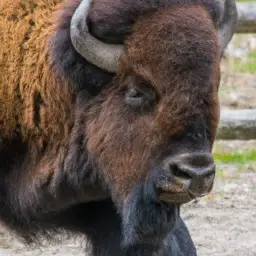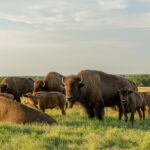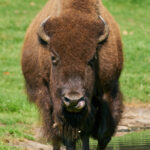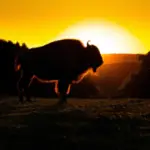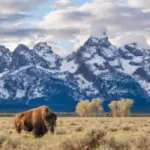Have you ever wondered about the sheer power and strength of a bison? Look no further than our product, “How Strong Is A Bison.” With a focus solely on this magnificent creature, we explore its incredible muscular abilities and delve into the world of bison strength. Through captivating visuals and expert insights, you’ll gain a deeper understanding of just how powerful these animals truly are. Get ready to be amazed by the strength of a bison like never before.
Understanding the Bison Species
Origins and History of Bison
The bison species, commonly known as buffalo, has a fascinating history that dates back to thousands of years. Native to North America, bison have roamed the vast grasslands and forests of this continent for centuries. They were a vital part of indigenous cultures and played a significant role in sustaining both humans and ecosystems. Sadly, due to human activities and hunting, bison populations were decimated to the brink of extinction. However, dedicated conservation efforts have helped these majestic creatures make a remarkable comeback.
Types of Bison
There are two recognized species of bison: the American Bison (Bison bison) and the European Bison (Bison bonasus). The American Bison is further classified into two subspecies: the Plains Bison and the Wood Bison. While the Plains Bison primarily inhabit the grasslands and prairies of North America, the Wood Bison can be found in the boreal forests of Canada. The European Bison, also known as the Wisent, is native to Europe and is the heaviest land animal on the continent.
Physical Characteristics of Bison
Bison are known for their immense size and strength. They have a robust build with a large head, humped shoulders, and a muscular frame. Adult males, also known as bulls, can weigh up to 2,000 pounds (900 kilograms), while females, known as cows, weigh slightly less around 1,100 to 1,200 pounds (500 to 550 kilograms). Their fur is typically brown and thick, providing insulation during harsh weather conditions. Bison also possess a remarkable set of horns, which serve as both weapons and a symbol of their dominance in the animal kingdom.
Bison’s Strength in Perspective
Comparison with Other Animals
In terms of strength, bison rank among the most powerful animals in the world. They possess incredible endurance and can run at speeds of up to 35 miles per hour (56 kilometers per hour). This is quite impressive when compared to other large animals such as the African elephant, whose top speed is around 25 miles per hour (40 kilometers per hour). Bison also excel in terms of agility and can navigate rough terrains with ease, making them formidable creatures in their natural habitat.
Physical Components Contributing to Their Strength
Several physical attributes contribute to the bison’s extraordinary strength. Firstly, their massive size allows them to exert great force, whether in combat or while charging through the wilderness. Secondly, their muscular structure is specifically designed for powerful movements, allowing them to overpower competitors or quickly escape predators. Lastly, their bone density is quite high, which further enhances their resilience and ability to withstand impact forces.
Physical Attributes of a Bison That Signify Strength
Weight and Size of a Bison
When it comes to size, bison truly stand out. Adult males can reach an impressive height of around 6 feet (1.8 meters) at the shoulder and measure up to 10 feet (3 meters) in length. Their sheer weight is also awe-inspiring, with bulls weighing between 1,000 to 2,000 pounds (450 to 900 kilograms) and cows averaging around 1,100 to 1,200 pounds (500 to 550 kilograms). This substantial mass allows bison to exert incredible force and dominance when necessary.
Muscle Structure of Bison
Bison possess a well-developed muscular system that contributes to their immense strength. Their powerful shoulder and neck muscles are particularly notable, enabling them to charge, dig, and fight with unrivaled strength. These muscles, combined with a highly efficient cardiovascular system, provide bison with the necessary power for sustained periods of physical activity, such as migration or battling rivals.
Comfortable Speeds and Maximum Speeds Achieved by Bison
Bison exhibit impressive speed, both in short bursts and over long distances. Their comfortable running speed typically ranges between 20 to 25 miles per hour (32 to 40 kilometers per hour), allowing them to swiftly cover significant ground. In cases of immediate danger or during mating season, bison can reach maximum speeds of up to 35 miles per hour (56 kilometers per hour), showcasing their agility despite their impressive bulk.
Bison’s Horns and Their Importance
Structure and Size of Bison Horns
One of the most recognizable features of a bison is its formidable horns. Both male and female bison possess horns, although those of the males tend to be larger and more prominent. These horns are made up of a keratin sheath covering a bony core. The size of the horns can vary greatly, with males showcasing longer and more massive horns compared to females. The largest recorded bison horns reached lengths of over 30 inches (76 centimeters) and possessed a circumference of more than 21 inches (53 centimeters).
Use of Horns in Combat
Bison rely on their horns as powerful weapons when it comes to battling rivals or defending themselves and their offspring. During the rutting season, adult males engage in intense fights to establish dominance and secure mating opportunities. They will clash their massive heads and horns together, producing thunderous sounds that echo across the plains.
Role of Horns in Display of Dominance
Apart from their combat functions, bison horns serve as a visual display of strength and dominance. A male bison with large and imposing horns is seen as a formidable opponent, both by other bison and potential competitors. The size and shape of their horns can often determine social hierarchy within the herd, ensuring that the strongest and most powerful individuals have access to the best resources and mates.
Bison’s Strength in Combat
Famous Bison Fights
Bison fights are truly a sight to behold. During the mating season, bulls engage in fierce battles to establish dominance and secure breeding rights. These confrontations involve charging at each other head-on, with the sound of clashing horns reverberating through the air. These fierce contests can continue for hours as the bulls test each other’s strength, endurance, and determination.
Bison as Predators and Prey
Although bison are primarily herbivorous animals, they may exhibit a surprising aggression when defending themselves or their young. They have been known to charge at predators, such as wolves or grizzly bears, using their immense strength to intimidate and fend off potential threats. However, bison are also preyed upon by predators, especially when they are vulnerable, such as during calving season or when weakened by old age.
Defense Mechanisms Leveraged by Bison
Bison have developed several defense mechanisms to protect themselves against threats. Their large size acts as a deterrent, making it challenging for predators to take down a fully grown bison. In addition to using their horns for combat, bison are also capable of delivering powerful kicks using their strong hind legs. When under attack, they will form defensive circles or tight groups, known as a “bison wall,” with the mature adults surrounding the young and vulnerable individuals, further enhancing their chances of survival.
Bison’s Strength in Adaptation
Adaptation to Different Habitats
Bison have proven themselves to be highly adaptable creatures, capable of thriving in diverse environments. While they are commonly associated with the vast grasslands of North America, they have also successfully adapted to other habitats such as forests and even the harsh northern tundra. Their ability to adjust their feeding habits and behaviors to different ecosystems demonstrates their resilience and tenacity.
Surviving Extreme Weather
Bison are well-suited to handle extreme weather conditions, including freezing temperatures and scorching heat. Their thick fur, layered with dense undercoats, provides insulation during harsh winters, while their ability to shed the outer layer in warmer seasons helps prevent overheating. Furthermore, their highly efficient metabolism allows them to efficiently convert food into energy, enabling them to withstand periods of food scarcity and survive in demanding climatic conditions.
Diet that Supports Their Strength
Bison are herbivores and primarily graze on grasses, sedges, and other plants available in their environment. Their diet consists of nutrient-rich vegetation that helps sustain their strength and muscular development. The ability to efficiently extract nutrients from these high-fiber sources is a testament to their remarkable physiological adaptations. By foraging for a varied diet, bison ensure they have the necessary energy and nutrients to maintain their exceptional strength and endurance.
Bison’s Role in the Ecosystem
Contribution to Biodiversity
Bison play a vital role in maintaining biodiversity within their ecosystems. By grazing on grasses, their feeding behavior influences the structure and composition of plant communities. This, in turn, creates habitats that are favorable for a wide range of organisms such as insects, birds, and small mammals. Bison also contribute to seed dispersal, aiding in the regeneration of plant species and promoting ecosystem health and resilience.
Bison’s Impact on the Environment
The presence of bison has profound effects on the environment around them, shaping landscapes through their feeding habits and movement patterns. Their grazing behavior helps maintain open grasslands, preventing the encroachment of woody vegetation and fostering the growth of a diverse array of plant species. Additionally, their trampling creates disturbances in the soil, promoting seed germination and nutrient cycling. These ecological processes, driven by bison, are essential for maintaining healthy and dynamic ecosystems.
Bison as a Keystone Species
Due to their ecological influence and unique adaptations, bison are considered a keystone species. As such, they have a disproportionate impact on their ecosystems, influencing community structure and ecosystem function. The removal or absence of bison can trigger significant changes in plant and animal populations, leading to the loss of biodiversity and disrupting ecosystem dynamics. Therefore, protecting and conserving bison populations is crucial for maintaining the overall health and balance of these ecosystems.
Conservation Efforts for Bison
Threats to Bison and Their Strength
Historically, bison populations faced numerous threats that severely impacted their strength and survival. Uncontrolled hunting, habitat loss, and competition for resources nearly drove bison to extinction. By the late 1800s, their numbers had plummeted to a mere few hundred individuals. The loss of genetic diversity within the remaining herds further weakened their robustness and adaptability. Despite these challenges, bison have shown remarkable resilience, thanks to dedicated conservation efforts and the establishment of protected areas.
Conservation Programs
Conservation programs have been instrumental in the recovery and restoration of bison populations. By implementing measures such as habitat protection, captive breeding programs, and translocation efforts, conservationists have successfully increased bison numbers and restored their range. Collaborative initiatives involving government agencies, indigenous communities, and conservation organizations have played a pivotal role in safeguarding these iconic creatures and their strong legacy.
Success Stories in Bison Conservation
Today, conservation efforts continue to yield encouraging results. Several success stories demonstrate the positive outcomes of committed conservation practices. The American Bison, once on the brink of extinction, now numbers over 500,000 individuals spread across protected areas, national parks, and private lands. The European Bison, while historically facing similar challenges, has rebounded from a population low of just over 50 individuals in the early 20th-century to more than 6,000 in the present day. These achievements underscore the importance and efficacy of conservation measures in preserving the strength and future of bison populations.
Bison in Culture and Mythology
Symbolism of Bison Strength in Various Cultures
The impressive strength of bison has captivated humans for centuries, ingraining the species with deep cultural significance. In various indigenous cultures, the bison represents power, resilience, and abundance. It is often viewed as a symbol of spiritual connectedness, embodying the interconnectedness of all living beings. Today, bison remain important cultural symbols, serving as a reminder of the enduring strength and majestic beauty of these remarkable creatures.
Bison in Folklore and Myths
Bison have also found their way into folklore and myths across different cultures. In Native American traditions, the bison is revered as a provider, embodying the spirit of abundance and prosperity. Numerous tales and legends depict their strength and courage, often casting them as protagonists in stories of survival and resilience. These ancestral narratives celebrate the bison’s unwavering power and its essential role in the cultural fabric of indigenous communities.
Portrayal of Bison Strength in Art and Literature
Throughout history, artists and writers have been inspired by the strength and majesty of bison. From cave paintings to contemporary sculptures, bison have been depicted as formidable creatures, embodying strength, freedom, and untamed wildness. In literature, bison have been featured in novels, poems, and essays, often representing the raw power of nature and serving as metaphors for human strength and determination.
Can A Bison’s Strength Help Them Defend Themselves?
When it comes to bison defense techniques and strategies, their immense strength is their greatest asset. With the ability to charge at speeds of up to 35 miles per hour, bison can easily fend off predators. Their size and powerful horns also make them formidable opponents, allowing them to defend themselves effectively in the wild.
Future of Bison and Their Strength
Effect of Climate Change on Bison
Climate change poses both challenges and uncertainties for the future of bison populations. Rising temperatures, shifting climatic patterns, and increased frequency of extreme weather events may alter the availability and quality of their habitats and food sources. These changes could impact the overall health, reproduction, and migration patterns of bison. However, the adaptability and resilience that have helped bison survive in the past may offer hope for their ability to cope with the changing climate.
Implication of Genetic Engineering and Breeding Programs
Advancements in genetic engineering and breeding programs hold potential benefits for bison populations. By understanding the genetic makeup of these animals, researchers can identify traits that contribute to their strength and resilience. This knowledge can guide selective breeding programs aimed at conserving and enhancing these vital characteristics. However, careful consideration must be given to preserving the genetic diversity of the species, as it is crucial for maintaining their adaptability and long-term survival.
Speculations about Future Populations
While bison populations have made significant recoveries in recent decades, the future remains uncertain. The ongoing preservation of suitable habitats, continued efforts in conservation, and public awareness are paramount for ensuring the long-term survival and strength of bison populations. With sufficient protection and collective action, it is possible to secure a future where bison continue to roam the landscapes, embodying the enduring strength that has captivated humanity for generations.
In conclusion, the strength of the bison is unquestionable. From their physical attributes and combat abilities to their adaptation and role within ecosystems, these magnificent creatures exhibit unrivaled power and resilience. Their significance in culture, mythology, and art further solidifies their position as an enduring symbol of strength. As we look ahead, we must continue to champion conservation efforts to safeguard their populations and preserve the legacy of the bison’s indomitable strength.

